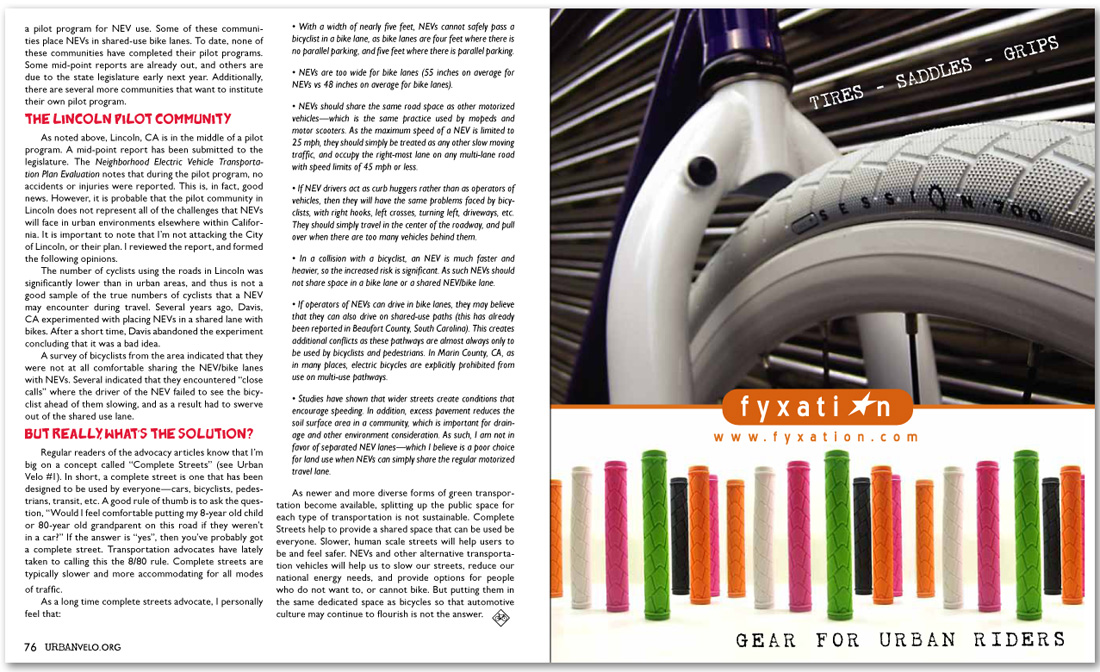


a pilot program for NEV use. Some of these communities place NEVs in shared-use bike lanes. To date, none of these communities have completed their pilot programs. Some mid-point reports are already out, and others are due to the state legislature early next year. Additionally, there are several more communities that want to institute their own pilot program.
The Lincoln Pilot Community
As noted above, Lincoln, CA is in the middle of a pilot program. A mid-point report has been submitted to the legislature. The Neighborhood Electric Vehicle Transportation Plan Evaluation notes that during the pilot program, no accidents or injuries were reported. This is, in fact, good news. However, it is probable that the pilot community in Lincoln does not represent all of the challenges that NEVs will face in urban environments elsewhere within California. It is important to note that I’m not attacking the City of Lincoln, or their plan. I reviewed the report, and formed the following opinions.
The number of cyclists using the roads in Lincoln was significantly lower than in urban areas, and thus is not a good sample of the true numbers of cyclists that a NEV may encounter during travel. Several years ago, Davis, CA experimented with placing NEVs in a shared lane with bikes. After a short time, Davis abandoned the experiment concluding that it was a bad idea.
A survey of bicyclists from the area indicated that they were not at all comfortable sharing the NEV/bike lanes with NEVs. Several indicated that they encountered “close calls” where the driver of the NEV failed to see the bicyclist ahead of them slowing, and as a result had to swerve out of the shared use lane.
But Really, What’s the Solution?
Regular readers of the advocacy articles know that I’m big on a concept called “Complete Streets” (see Urban Velo #1). In short, a complete street is one that has been designed to be used by everyone—cars, bicyclists, pedestrians, transit, etc. A good rule of thumb is to ask the question, “Would I feel comfortable putting my 8-year old child or 80-year old grandparent on this road if they weren’t in a car?” If the answer is “yes”, then you’ve probably got a complete street. Transportation advocates have lately taken to calling this the 8/80 rule. Complete streets are typically slower and more accommodating for all modes of traffic.
As a long time complete streets advocate, I personally feel that:
• With a width of nearly five feet, NEVs cannot safely pass a bicyclist in a bike lane, as bike lanes are four feet where there is no parallel parking, and five feet where there is parallel parking.
• NEVs are too wide for bike lanes (55 inches on average for NEVs vs 48 inches on average for bike lanes).
• NEVs should share the same road space as other motorized vehicles—which is the same practice used by mopeds and motor scooters. As the maximum speed of a NEV is limited to 25 mph, they should simply be treated as any other slow moving traffic, and occupy the right-most lane on any multi-lane road with speed limits of 45 mph or less.
• If NEV drivers act as curb huggers rather than as operators of vehicles, then they will have the same problems faced by bicyclists, with right hooks, left crosses, turning left, driveways, etc. They should simply travel in the center of the roadway, and pull over when there are too many vehicles behind them.
• In a collision with a bicyclist, an NEV is much faster and heavier, so the increased risk is significant. As such NEVs should not share space in a bike lane or a shared NEV/bike lane.
• If operators of NEVs can drive in bike lanes, they may believe that they can also drive on shared-use paths (this has already been reported in Beaufort County, South Carolina). This creates additional conflicts as these pathways are almost always only to be used by bicyclists and pedestrians. In Marin County, CA, as in many places, electric bicycles are explicitly prohibited from use on multi-use pathways.
• Studies have shown that wider streets create conditions that encourage speeding. In addition, excess pavement reduces the soil surface area in a community, which is important for drainage and other environment consideration. As such, I am not in favor of separated NEV lanes—which I believe is a poor choice for land use when NEVs can simply share the regular motorized travel lane.
As newer and more diverse forms of green transportation become available, splitting up the public space for each type of transportation is not sustainable. Complete Streets help to provide a shared space that can be used be everyone. Slower, human scale streets will help users to be and feel safer. NEVs and other alternative transportation vehicles will help us to slow our streets, reduce our national energy needs, and provide options for people who do not want to, or cannot bike. But putting them in the same dedicated space as bicycles so that automotive culture may continue to flourish is not the answer.